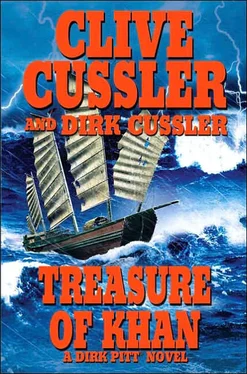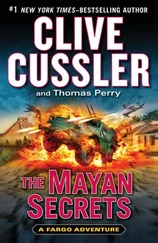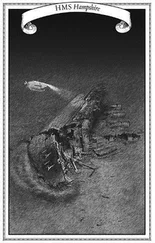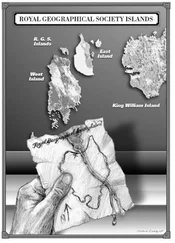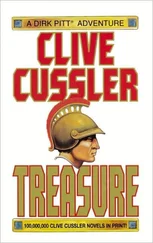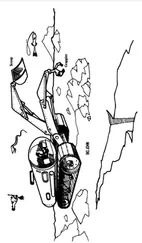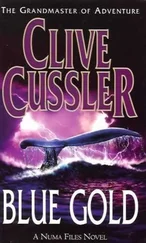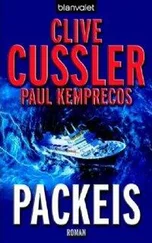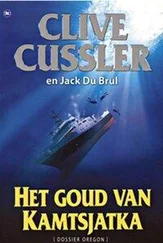He guided the cursor to the crown of the sedimentary cut and clicked the button. An illuminated crosshair began flashing over the indicated point as the tripod ticked again. Gunn rolled the cursor to the top of the screen and quickly scrolled through a series of dropdown menus. Sweat began dripping off his forehead as he worked frantically in the hot chamber. Each new command was in German, the software having been created by von Wachter and his team. Gunn desperately tapped the recesses of his brain, trying to resurrect forgotten words and phrases. He recalled Yaeger's report that von Wachter was using concentrated packets of high-frequency waves in his imaging, so he selected the highest-frequency setting. He guessed WEITE meant amplitude, and chose the highest power level, then selected a repetitive cycle interval of twenty seconds. A flashing red box appeared with AKTIVIEREN in bold letters. Gunn mentally crossed his fingers and clicked the button.
At first, nothing happened. Then a long sequence of software script rolled across the monitor at rapid speed. It might have been Gunn's heightened senses, but the power amplifiers and computers physically seemed to come alive in the chamber, bursting with a low hum. Wiping his brow, he was certain the room temperature had increased by at least ten degrees. He noticed the tripod was ticking again, but at a higher crescendo. Then with a flicker of the lights, an explosive boom erupted from the inverted tip of the tripod. It felt like a bolt of lightning had struck just inches away. The acoustic blast shook the building, nearly tossing Gunn from his chair. He staggered toward the door with his ears ringing, then stopped and gazed at the room in dismay.
The anechoic chamber. It was designed to absorb sound waves. Even the concentrated blasts erupting from the acoustic array would be seriously diluted by the sound-deadening floor panels. His effort at activating the system was for naught.
Gunn jumped off the catwalk onto the foam floor and vaulted over to the base of the tripod. He anticipated the next blast and covered his ears as a second acoustic burst was fired from the transducer tubes, expounding with a deafening bang.
The thunderclap knocked Gunn to his knees, but he quickly recovered and crawled to the base of the tripod. Frantically tearing at the foam floorboards beneath the device, he counted out loud to twenty in anticipation of the next blast. Luck was on his side, as the foam panels were not attached to the floor and lifted off easily in large sections. Beneath the foam, the floor appeared tiled, but Gunn saw from the dull silver finish that the tiles were made of lead as an extra sound deadener. Gunn was at the count of eleven when he lunged at the console and grabbed the crowbar he had left on the table. Jamming its blade into a floor seam, he quickly pried up one of the heavy tiles and muscled it aside. Ignoring his count of eighteen, he dove down and quickly ripped away three other lead plates, which together with the first had formed a square beneath the business end of the acoustic array.
Gunn had counted too fast during his adrenaline rush to clear the floor and stepped back just as the third acoustic blast fired. Jamming his palms to his ears, he looked down as saw that the device was now firing through a thin layer of concrete that had formed the foundation for the building.
"Nothing I can do about that," he muttered after the blast passed, and he made his way to the door.
Tugging open the heavy door, he half expected to face a legion of armed guards waiting for him to exit.
But the guards had all rushed to the residence, at least temporarily. Instead, he saw a small group of scientists, some in pajamas, swarming at the opposite end of the hallway. Stepping through the chamber door, Gunn was met by a yell from one of the scientists, spurring the angry mob to charge toward him.
With just a few yards of leeway, Gunn rushed to the nearest office on his right and stepped in.
Like most of the offices in the lab building, it was sparsely decorated, with a gray metal desk centered on one wall and a lab table covered with electronics to the side. None of the furnishings mattered to Gunn. The only thing of importance was the small picture window that faced the compound grounds.
Stepping to the window, he silently thanked Giordino for loaning him the crowbar now gripped tightly in his hands. With a powerful thrust, he jabbed the blunt end of the bar into a corner of the window, shattering the glass. Scraping the broken shards off the sill, he dove out the window. His body barely hit the ground when the fourth and final blast emitted from the acoustic array, the impact much less violent to Gunn now that he was outside the building.
A chorus of frantic yells could be heard through the broken window as the scientists ignored Gunn and rushed into the chamber. He knew they would deactivate the system before another blast would strike.
His rash gamble at inducing an earthquake was finished. So too, he thought with dread, was his chance at saving the lives of Pitt and Giordino.
When the sound of the second blast echoed across the compound, Borjin ordered two of the mounted guards to go investigate. They quickly galloped across the darkened compound as a slight rumble echoed in the distance. The deep boom of a third seismic blast quickly drowned out their pounding hoofbeats and the faraway rumble as well.
"You have brought friends as well?" Borjin sneered at Pitt.
"Enough to close you down for good," Pitt replied.
"Then they shall die with you."
A crash of shattering glass sounded from the laboratory, followed by the fourth detonation of the acoustic seismic array. Then all fell silent.
"It would appear that your friends have been introduced to my guards," Borjin smiled.
The sneer was still on his face when another distant rumble reverberated off the hills like the sound of approaching thunder. Only this time, the rumble continued to resonate, growing with the intensity of an approaching avalanche. Outside the compound walls, a pack of wolves nearby began howling in mournful unison. The horses inside the compound picked up the cue and began neighing loudly, in nervous anticipation of the pending cataclysm that their human counterparts could not foresee.
A thousand meters below the surface, a trio of condensed sound waves, fired from the three transducers, converged at the angled fracture targeted by Gunn. The sedimentary cut was indeed an ancient oblique fault. The first two blasts of the seismic array, dissipated by the chamber's shielding, had struck the fault with only a minor pulse. The third blast, however, hit with the full power of the convergent shock waves. Though the sediment held firm, the seismic waves rocked with a vibrating force that rattled the fault line. When the fourth blast arrived, it would prove enough to break the camel's back.
A fault line, by nature, is a rock fracture prone to movement. Most earthquakes are the result of energy released from a slippage in a fault zone. Pressure builds up at a point along the fault due to underlying tectonic movement until a sudden slippage relieves the strain. The slippage reverberates to the surface, sending out a variety of shock waves that create a surface-rattling earthquake.
For the fault beneath the Mongolian mountainside, the fourth and final barrage of acoustic waves struck like a torpedo. The seismic vibrations jolted the fracture, causing it to slip in both vertical and horizontal directions. The buckle was small, just a few inches spread across a quarter-mile rift, but because it was close to the surface the wave impact was dramatic.
The shock waves burst through the ground in a sinister turmoil of vertical and horizontal shaking. By the Richter scale, the resulting quake would measure a 7.5 magnitude. But the scale didn't reflect the true intensity on the surface, where the shaking felt ten times more powerful to those standing on the ground.
Читать дальше
